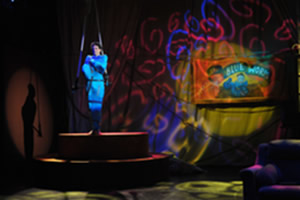A clear highlight of the current season was the stunning performance of Rachmaninoff’s All-Night Vigil, a.k.a. Vespers, Op. 37, presented in Raleigh’s new Holy Name of Jesus Cathedral by the North Carolina Master Chorale. The work, the composer’s next-to-last for chorus, immediately followed his Piano Sonata No. 2 and, before that, The Bells, for soloists, chorus, and orchestra – said to have been his personal favorite. The Vigil is one of two large-scale works for unaccompanied chorus, written for use in the Russian Orthodox Church. The other one is The Divine Liturgy of St. John Chrysostom. Op. 31, which the NCMC presented in the Triangle in 2014.
The sanctuary is large, with a seating capacity of 2,000 – 1,000 in the nave and 500 in each of the two transepts (making it comparable to cathedrals in Baltimore and Philadelphia). For the record, Duke Chapel, completed in 1932, seats 1,800. The two rooms offer similar acoustical challenges, the greatest of which is reverberation. On this occasion, Holy Name of Jesus Cathedral was filled to capacity. Amplified welcoming remarks from the Cathedral’s music director reached listeners in highly garbled form, raising alarm at the prospects of the massed choir. The NCMC was however not given any electronic assistance, and its music director, Alfred E. Sturgis, a veteran of an earlier performance (of Mozart’s Requiem, reviewed here) in this space, has clearly mastered the room’s sonic liabilities, at least as heard from close to the performers (in this instance, from row 11, center).
HNJC was adorned with numerous floral arrangements and is by design and architectural appointment open, light, and airy. The choir was huge; it was arrayed in at least eight rows across the front, with additional singers massed along both sides, completely filling the area between the first pews and the altar. Visually, the effect was impressive. Aurally, it was impressive, too.
The soloists were alto Shannen Knapp, a member of the NCMC, whose voice seemed tailor-made for her short contribution in “Bless the Lord, O My Soul,” in which her lines alternated with restrained singing from the chorus. The tenor has a good deal more to do; here, the venerable, always-reliable Wade Henderson was heard. He seemed to have misjudged his volume at the start of “O Serene Light” but was highly effective in “The Prayer of St. Simeon” (the “Nunc Dimittis”) and “Blessed Art Thou, O Lord.” Truth to tell, there’s not much for the tenor to do either, with the second of these three containing his largest solos. In each contribution, Henderson’s radiant voice rang true, even bordering on the angelic – figuratively and literally, too – in the sections concerning the resurrection in “Blessed Art Thou.”
The chorus itself was, throughout, exemplary. This is not easy fare. It was sung in Church Slavonic, which means the texts were learned phonetically by most of the vocalists – a transliteration and translation were provided to attendees. The score is in four parts, often subdivided; readers may see the music here, with original and English texts. The singers were arrayed in sections, with sopranos on the audience’s left, then the tenors, basses, and altos, moving across to the right. The chorus director who advised the composer was stunned by the demands on the low basses, famously telling him that singers with depth like that are as rare as asparagus at Christmas; here, the basses came through most honorably. By all conventional standards of measuring choruses, the NCMC earned top marks – in diction, projection, balance, blend, attacks, releases, phrasing, dynamics, crispness, precision – you name it, they did it, and beautifully, throughout. The texts of course appeal to all sensitive people – not just Christians, who surely constituted the majority of this audience, but everyone. Coming as it did on the last day of Passover, and on a day that brought us yet another shooting at a synagogue, on the West Coast, the messages of the text and the serenity of the music were needful, helpful, comforting, and reassuring. The concert lasted just a little over an hour, and the end brought heartfelt applause and many grateful standees. In truth, we were richly blessed to hear this fine rendition in this lovely sacred space.
Sturgis’ brief program note addressed the sources of the old chants, used in several numbers, many of which tunes were pre-ordained, as it were. Those notes are worth reading, for among other things they underscore the triumph Rachmaninoff achieved with this music. It’s not the Rachmaninoff most concert-goers might have expected, but he was a deeply devout man and this work came from his heart. The director also indicates that this Vespers is, as noted, more than that. In a liturgical context it would be an all-nighter, with (as he writes) “Vespers, Matins, and First Hour” sections. To experience this sort of thing as it might have been envisioned, one must go to one of the great Russian Orthodox Churches, where music is set off by the appropriate texts, often chanted. A favorite is New York’s Holy Virgin Protection Cathedral, near the Bowery, where for a time the choral director was Nicholas Afonsky, who as a young man had worked with the great Feodor Chaliapin in Paris, and whose Westminster recordings with the New York choir helped introduce the music of the Orthodox Church to thousands of music lovers around the world. (Here’s a sample of Chaliapin and Afonsky working together, in music by Gretchaninoff.*)
For more information on the theology involved in Vespers, see this online article and also this one.
*This sample is enough to make one wish that Old Stone Face (Rachmaninoff, not Buster Keaton) had troubled himself to write a bass solo into Vespers for his near-contemporary operatic pal.











